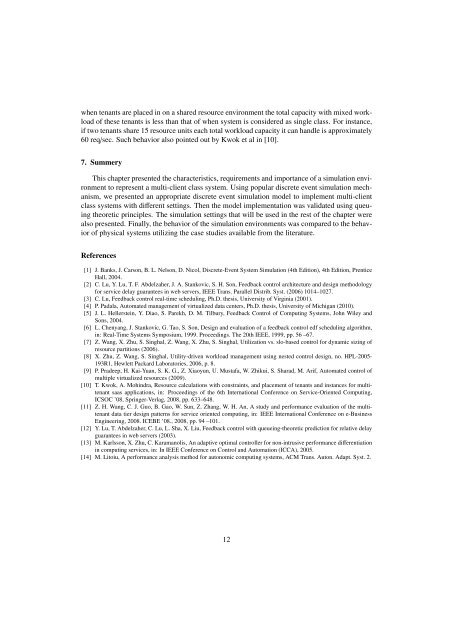A simulation model to implement multiple client class server-client ...
A simulation model to implement multiple client class server-client ...
A simulation model to implement multiple client class server-client ...
You also want an ePaper? Increase the reach of your titles
YUMPU automatically turns print PDFs into web optimized ePapers that Google loves.
when tenants are placed in on a shared resource environment the <strong>to</strong>tal capacity with mixed workload<br />
of these tenants is less than that of when system is considered as single <strong>class</strong>. For instance,<br />
if two tenants share 15 resource units each <strong>to</strong>tal workload capacity it can handle is approximately<br />
60 req/sec. Such behavior also pointed out by Kwok et al in [10].<br />
7. Summery<br />
This chapter presented the characteristics, requirements and importance of a <strong>simulation</strong> environment<br />
<strong>to</strong> represent a multi-<strong>client</strong> <strong>class</strong> system. Using popular discrete event <strong>simulation</strong> mechanism,<br />
we presented an appropriate discrete event <strong>simulation</strong> <strong>model</strong> <strong>to</strong> <strong>implement</strong> multi-<strong>client</strong><br />
<strong>class</strong> systems with different settings. Then the <strong>model</strong> <strong>implement</strong>ation was validated using queuing<br />
theoretic principles. The <strong>simulation</strong> settings that will be used in the rest of the chapter were<br />
also presented. Finally, the behavior of the <strong>simulation</strong> environments was compared <strong>to</strong> the behavior<br />
of physical systems utilizing the case studies available from the literature.<br />
References<br />
[1] J. Banks, J. Carson, B. L. Nelson, D. Nicol, Discrete-Event System Simulation (4th Edition), 4th Edition, Prentice<br />
Hall, 2004.<br />
[2] C. Lu, Y. Lu, T. F. Abdelzaher, J. A. Stankovic, S. H. Son, Feedback control architecture and design methodology<br />
for service delay guarantees in web <strong>server</strong>s, IEEE Trans. Parallel Distrib. Syst. (2006) 1014–1027.<br />
[3] C. Lu, Feedback control real-time scheduling, Ph.D. thesis, University of Virginia (2001).<br />
[4] P. Padala, Au<strong>to</strong>mated management of virtualized data centers, Ph.D. thesis, University of Michigan (2010).<br />
[5] J. L. Hellerstein, Y. Diao, S. Parekh, D. M. Tilbury, Feedback Control of Computing Systems, John Wiley and<br />
Sons, 2004.<br />
[6] L. Chenyang, J. Stankovic, G. Tao, S. Son, Design and evaluation of a feedback control edf scheduling algorithm,<br />
in: Real-Time Systems Symposium, 1999. Proceedings. The 20th IEEE, 1999, pp. 56 –67.<br />
[7] Z. Wang, X. Zhu, S. Singhal, Z. Wang, X. Zhu, S. Singhal, Utilization vs. slo-based control for dynamic sizing of<br />
resource partitions (2006).<br />
[8] X. Zhu, Z. Wang, S. Singhal, Utility-driven workload management using nested control design, no. HPL-2005-<br />
193R1, Hewlett Packard Labora<strong>to</strong>ries, 2006, p. 8.<br />
[9] P. Pradeep, H. Kai-Yuan, S. K. G., Z. Xiaoyun, U. Mustafa, W. Zhikui, S. Sharad, M. Arif, Au<strong>to</strong>mated control of<br />
<strong>multiple</strong> virtualized resources (2009).<br />
[10] T. Kwok, A. Mohindra, Resource calculations with constraints, and placement of tenants and instances for multitenant<br />
saas applications, in: Proceedings of the 6th International Conference on Service-Oriented Computing,<br />
ICSOC ’08, Springer-Verlag, 2008, pp. 633–648.<br />
[11] Z. H. Wang, C. J. Guo, B. Gao, W. Sun, Z. Zhang, W. H. An, A study and performance evaluation of the multitenant<br />
data tier design patterns for service oriented computing, in: IEEE International Conference on e-Business<br />
Engineering, 2008. ICEBE ’08., 2008, pp. 94 –101.<br />
[12] Y. Lu, T. Abdelzaher, C. Lu, L. Sha, X. Liu, Feedback control with queueing-theoretic prediction for relative delay<br />
guarantees in web <strong>server</strong>s (2003).<br />
[13] M. Karlsson, X. Zhu, C. Karamanolis, An adaptive optimal controller for non-intrusive performance differentiation<br />
in computing services, in: In IEEE Conference on Control and Au<strong>to</strong>mation (ICCA), 2005.<br />
[14] M. Li<strong>to</strong>iu, A performance analysis method for au<strong>to</strong>nomic computing systems, ACM Trans. Au<strong>to</strong>n. Adapt. Syst. 2.<br />
12
















